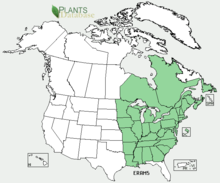Yellow trout lily

Overview
The yellow trout lily (Erythronium americanum) is a common spring ephemeral wildflower that is part of the Liliaceae family and is native to the northeastern United States and eastern Canada. It is a perennial that grows in colonies and blooms between March and May. Each plant produces one nodding bright yellow flower with backwards bending petals and has dark green leaves that are mottled with a purplish-brown coloration. The leaves are where the flower gets its name from: the mottled coloration is said to be similar to the markings on trout. Other names for the yellow trout lily include the American trout lily, eastern trout lily, yellow dogtooth violet, and adder's tongue. [1][2]

Growth and Reproduction
The natural habitat of yellow trout lilies is deciduous woodland, and they grow best in moist, acidic soil with part sun. The plants tend to grow in clumps, forming dense clusters of leaves and flowers, and typically reach 3 to 6 inches in height.[1] The flower sprouts, blooms, produces fruit, and dies before canopy trees fully leaf out.Cite error: Closing </ref> missing for <ref> tag[3] Each flower contains 4-7 seeds that are typically released in June and July and dispersed by ants, about 40% of which will successfully germinate.[3][4] Interestingly, although yellow is the most common color for pollen in flowering plants, the pollen and anther color of yellow trout lilies can be either red or yellow. This variation has allowed researchers to track pollen distribution from these plants. One 2018 study found that specific pollinators may have preferences for one pollen color over the other.[5]

==
References
- ↑ 1.0 1.1 University of Texas. (19 March 2019). Erythronium americanum. https://www.wildflower.org/plants/result.php?id_plant=eram5
- ↑ Wild Adirondacks. Wildflowers of the Adirondacks: Trout Lily (Erythronium americanum). https://wildadirondacks.org/adirondack-wildflowers-trout-lily-erythronium-americanum.html
- ↑ 3.0 3.1 Tessier, J. T. (2012). Methods of belowground movement in Erythronium americanum. Northeastern Naturalist, 19(sp6), 77-88.
- ↑ Muller, R. N. (1978). The phenology, growth and ecosystem dynamics of Erythronium americanum in the northern hardwood forest. Ecological Monographs, 48(1), 1-20.
- ↑ Austen, E. J., Lin, S. Y., & Forrest, J. R. (2018). On the ecological significance of pollen color: a case study in American trout lily (Erythronium americanum). Ecology, 99(4), 926-937.